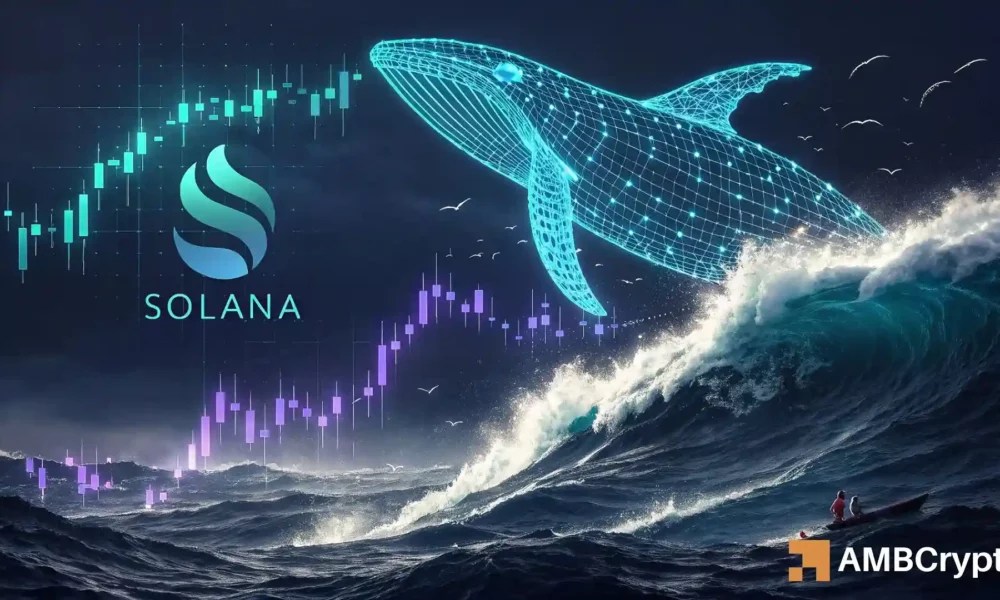The post Cardano whale loses 90% ADA after conversion to an illiquid stablecoin appeared com. Key Takeaways Why did the whale lose $6M? The low liquidity triggered fluctuations and a subsequent devaluation of the swapped funds. What’s the status of Cardano DeFi? Besides a relatively low TVL, Cardano’s ecosystem is struggling with a limited stablecoin supply. A Cardano [ADA] whale got a painful lesson on trading on illiquid platforms over the weekend. The 5-year-old holder swapped 14. 4 million ADA tokens, worth $6. 9 million, for only 847, 695 USDA, a little-known USD-backed stablecoin by Anzens on the Cardano blockchain. That translated to a $6. 05 million loss or about 90% devaluation of his initially transferred ADA stash. According to renowned Web3 security analyst ZachXBT, the fluctuation was due to the stablecoin’s low liquidity. As of writing, he scooped Turtlecoin (TRTL) and other lesser-known coins. Cardano DeFi liquidity problem That said, the Anzens USDA had only $10 million in market cap, underscoring its liquidity risk, especially for large transactions. For a frictionless trading experience, the volume and liquidity of a platform, as well as its assets, are always crucial. Players can smoothly enter and exit positions without distorting the market or incurring losses in a more liquid venue. On centralized platforms, Binance, Coinbase, and others rank high in terms of liquidity, which attracts players with large orders. On on-chain platforms, DEXes across Ethereum [ETH], Hyperliquid [HYPE], Solana [SOL], and BNB Chain platforms have demonstrated significant liquidity depths, providing a smooth experience. But such depths are lacking across the Cardano ecosystem. Its low stablecoin supply is one of the telltale signs of Cardano’s DeFi inefficiency. It had only $38 million in stablecoin liquidity, mostly dominated by Moneta dollar (USDM) and Anzens USDA.
Category: general
Devils in action against the Lightning after shootout victory
Ignore our burgeoning autocracy at your own risk | Opinion
TLDR Gold investor Peter Schiff labeled Strategy’s business model a “fraud” and challenged founder Michael Saylor to a debate in Dubai this December Schiff claims Strategy’s preferred shares offer yields that will never be paid, predicting a “death spiral” when fund managers realize this Bitcoin has dropped over 20% from its October all-time high above [.] The post Peter Schiff Calls Strategy’s Bitcoin Model a Fraud, Challenges Michael Saylor to Debate appeared first on CoinCentral.
The YouTuber claims he’s being targeted by Tennessee authorities over a legal car registration loophole.
Happy birthday Gene Clark (Byrds). We’re still here without you. Hüsker Dü takes on the Byrds’ “Eight Miles High” (co-written by Clark) at MAGNET: The post Happy Birthday Gene Clark (Byrds) appeared first on Magnet Magazine.
Irfan Pathan picks Mumbai Indians playing 11 for IPL 2026; chooses Indian superstar as Impact Player

Former Indian all-rounder Irfan Pathan believes five-time champions Mumbai Indians (MI) have all bases covered even before entering the IPL 2026 auction.
This actress left her career when she was the highest-paid actor in India. Later, she passed away at 54.
The post Solana faces heavy selling as whales flip bearish What’s next? appeared com. Key Takeaways Is there pressure on Solana’s price? A Solana whale recently exited a $4. 71 million position at a loss, lending weight to the bearish pressure on the altcoin. Are SOL’s metrics leaning bearish too? Yes, raising questions about whether Solana’s demand zone can continue to absorb this selling pressure. Solana’s (SOL) price action has taken a big hit lately. At the time of writing, the altcoin’s large players seemed to be aggressively accumulating short positions at its trading price. For instance Whale DYzF92 dumped 33, 366 SOL valued at $4. 71 million despite locking in a $230,000 loss. According to Lookonchain’s recent reports, the tokens were accumulated roughly seven months ago, making the sell-off a clear signal of shifting sentiment among major holders. Could the demand zone absorb whales’ bearish pressure? The whale’s exit adds more damage to an already fragile Solana market environment. According to AMBCrypto’s latest analysis, other large wallets have mirrored the same trend, stacking more short positions and signalling expectations of a near-term downturn. In fact, CryptoQuant’s Spot average order size data hinted at a surging number of whale orders around the current trade. And, with the positions’ distribution metrics indicating short positions’ dominance, most of the accumulated orders may be likely from Solana bears. On the daily chart, Solana’s price has been testing a well-defined demand zone around $14o A strategic price level where buyers could step in consistently. The zone had previously triggered relief bounces, making it a critical battleground between bulls and bears. If this zone absorbs whale-driven selling again, SOL could maintain its structure. However, if it fails, the.







